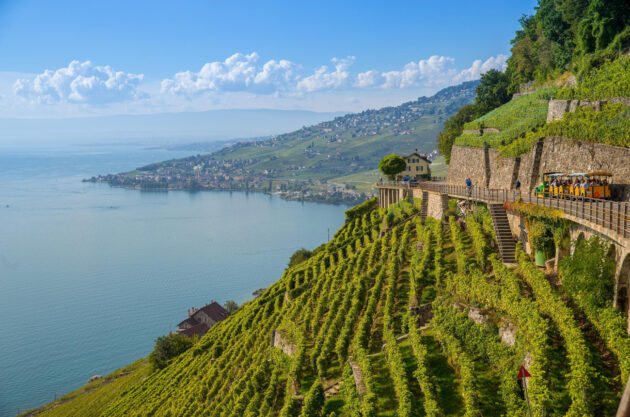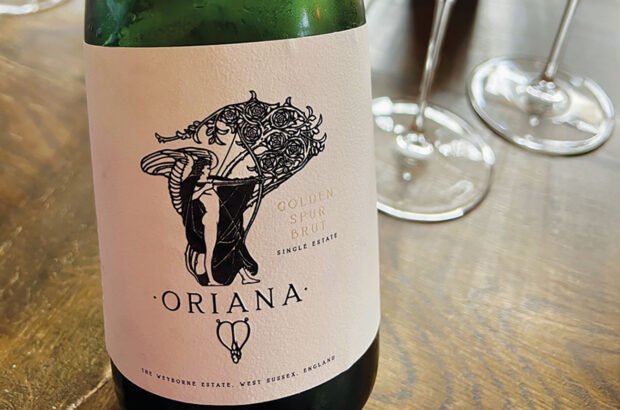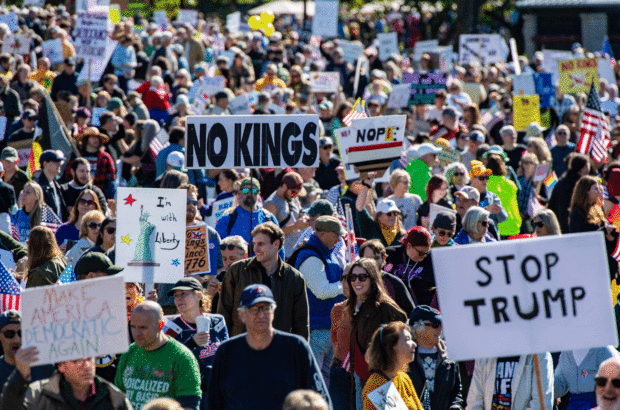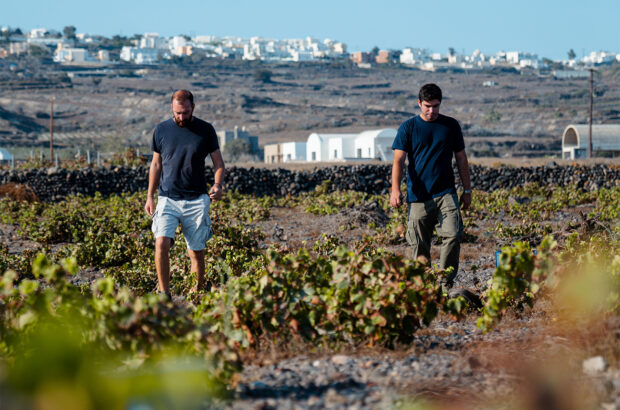Switzerland’s Canton of Vaud – about the same size as the Rhône department in France or Gloucestershire in the UK – has it all for the eclectic traveller. Montreux, home of the world’s most famous jazz festival; Lausanne, the global Olympic Capital; Vallée de Joux, the cradle of Swiss watchmaking, oozy Vacherin de Mont d’Or cheese, Swiss Riviera glamour…
And let’s not forget about the wine. Vaud is Switzerland’s second-largest wine-growing region, producing a quarter of the country’s wine from its six sub-regions. One of these is not only in the heart of the action, but its dramatic beauty, between Alps and lake, catapults it to the top of the Vaudois travel bucket list.
The Lavaux – the largest contiguous wine region in Switzerland – comprises about 800ha of vineyard terraces on the south-facing mountain slopes above Lake Geneva (Lac Léman) which stretch for 30km from the eastern outskirts of Lausanne to the Château de Chillon, just beyond Montreux.

Lavaux’s vineyard terraces are UNESCO World Heritage listed. Credit: MySwitzerland.com
The region was given UNESCO World Heritage status in 2007, to recognise and protect its significance as a centuries-long living cultural landscape – stone terraces that still stand today can be traced back to the 11th century, when Benedictine and Cistercian monasteries owned the land.
Today there are more than 10,000 of these terraces – some so narrow they only protect a single row of vines. If laid end to end, they would stretch more than 400km.
Villages and vines
While 14 villages comprise the Lavaux appellation, Dézaley and Calamin are the two designated grand crus. Dézaley – where the monks began their terraces – is one of Switzerland’s most famous vineyards, rising from Lac Léman at gradients of up to 100% (a 45° slope).
In addition to providing a breathtaking backdrop for photos, the lake plays a key role in the vineyard too. While not the Med, the Swiss Riviera enjoys a mild climate and the lake moderates temperatures further, as well as reflecting sunlight back on to the vines. This, combined with the heat retained by the stone walls, means the grapes enjoy an even ripening throughout the growing season.

Harvesting Chasselas on Lavaux’s steep slopes. Credit: MyVaud.ch
Chasselas represents about 60% of all plantings here, and more than 90% of white grapes. Most wineries have one or more reds from Pinot Noir, Gamay or the twin crossings of Gamay and Reichensteiner called Gamaret and Garanoir, but Chasselas is undoubtedly the star.
It’s a grape that can show many sides to its personality, depending on the individual terroir (in Lavaux, soils range from marl, sandstone, clay, moraine and more), and how it is handled, both in the vineyard and winery.
Resulting wines can be anything from simple, fruity quaffers to more complex, weighty styles, and through the gamut of leesy, creamy barrel-fermented and aged examples. On the palate, expect moderate alcohol, bright acidity, flinty notes and pithy apricot and citrus blossom flavours that develop truffle and nougat tones with age.
Exploring the terraces
Walking is the best way to experience Lavaux’s historic terraces, vertiginous slopes and jaw-dropping scenery of vines, Alps and lake. The Lavaux World Heritage Association has two guided walking tours to book between May and October – a 3km, 2.5-hour ‘heritage hike’ on Saturday mornings and a shorter, more relaxed stroll on Sundays (from CHF20/£18 per person).
The Montreux Riviera tourist office, meanwhile, has mapped out a 2km walk between Epesses and Chexbres along which you can scan QR codes on panels along the way to get anecdotes, history and details on wines available from each vineyard you pass. Or to plan your own path, it has 40 walking, hiking, running and cycling routes across the Riviera region; the best one for the Lavaux vineyard terraces is Route 113, a 11.3km trail from St-Saphorin to Lutry.

Rest your legs and enjoy epic views from the Lavaux Express train. Credit: Morges-Tourisme.ch
If that feels too much exertion, soak up the majestic vistas from one of the two wheeled trains that cross the terraces. The green and yellow Lavaux Express runs two loops: one around Lutry and Grandvaux; the other encompassing the vineyards of Cully, Epesses and Dézaley (CHF17). The white Lavaux Panoramic, meanwhile, runs between Chexbres, St-Saphorin and Chardonne (CHF16). There are also several tours available to book on each train, including themed and seasonal excursions incorporating winery visits and tastings.
Between the many photo opportunities, find time for a few winery visits. This is a patchwork region of small growers, some of whom only work a handful of vines each, passed down through the generations. While it is advisable to book ahead, you’ll feel more like you’re dropping to sit on a friend’s patio for a drink and a chat than being given a slick spiel.
Winery visits
Opposite Grandvaux train station is Domaine Croix Dupleix, run by third-generation winemaker Maude Vogel. While she works with 14 varieties, her passion is showcasing the different Lavaux terroirs through 10 Chasselas cuvées – the pinnacle being the Argile Dézaley Grand Cru.
Louis Bovard in Cully is synonymous with Chasselas – not least in being a perennial medallist at the Decanter World Wine Awards; the Ilex cuvée from Calamin Grand Cru is delicious. Louis-Philippe Bovard, the 10th generation custodian of the family name and estate, is so determined to raise the variety’s profile as serious and ageworthy, he created the World Conservatory of Chasselas, researching 19 variants of the grape.

The Massy family (foreground) and their Clos du Boux residence (top left). Credit: Massy-Vins.ch
La Maison Massy is now run by fourth-generation brothers Gregory and Benjamin. Try their Clos du Boux, from a 1.7ha walled vineyard next to the grand 1630-built Massy residence of the same name at the top of Epesses village. Or the Chemin de Fer cuvée, from vines grown right next to the train line at the bottom of the Grand Cru Dézaley slope, making harvest time even more precarious than usual.
Also in Epesses village is Blaise Duboux. This 5ha estate has been in the Duboux family for more than 500 years, with Blaise the 17th generation winemaker. The wines are certified organic, but farmed biodynamically, the Les Murets, from a parcel in Villette, is savoury and complex.
Not far from Chexbres station is Domaine Bovy, a family estate since 1779, but dating from the 16th century. Before a tasting on the veranda (the St-Saphorin Vielles Vignes is the pick of the five Chasselas), visit the cellar to see the oak foudres which, since the 1940s, have been painted with images of the Bovy family and tableaux of Lavaux life.
Lavaux wine festivals
While a visit to Lavaux is memorable at any time of year, try to coincide your trip with one of the region’s many wine festivals.
On the first Saturday of May each year (3 May 2025), some two dozen winemakers in Epesses and Calamin join together to showcase the new vintage at Epesses Nouveau. And on the last Saturday (31 May 2025), Chardonne holds its annual Wine Market, where you can taste and buy wine from producers across Lavaux.

The Lutry Harvest Festival is a highlight of the Vaud wine calendar. Credit: FeteDesVendanges.ch
As part of Vaud Open Cellars, which sees more than 250 winemakers across the canton welcome visitors for tours and tastings over the Pentecost weekend each year, 89 wineries from Lavaux are participating in 2025 (7-8 June). The two-day tickets (CHF40 each) include a tasting glass, free transport across the entire canton as well as a CHF20 discount off one six-bottle purchase.
But the event not to miss is the annual three-day Lutry Harvest Festival, held on the last weekend of September (26-28 September 2025). Running since 1947, it is one of the biggest events in French-speaking Switzerland, celebrating the rich winemaking heritage of the Lavaux region in a colourful procession of floats, costumes, music and of course cellar-door tastings and street bars.
My perfect day Lavaux
Morning
Enjoy a leisurely breakfast on the terrace at Les Trois Couronnes then head to Vevey train station. Take the 30-minute scenic journey to Grandvaux, changing at Puidoux, and visit winemaker Maude Vogel at her family domaine, Les Croix Dupleix, opposite the station, for a late-morning tasting on the patio. Head to Maison Lavaux in time for its 1pm opening for an audio tour on the history and living cultural landscape of Lavaux’s UNESCO World Heritage listed vineyards.

Remember your camera and walking shoes! Credit: Lausanne-Tourisme.ch
Lunch and afternoon
Minutes away is Tout un Monde, for its inventive lunch menu, inspired by a global cuisine each month. Take your time wandering back the 5.5km through the vineyards, including the grands crus of Calamin and Dézaley, along Route de la Corniche – there are plenty of photo opportunities of the beautiful terraces stretching down to Lac Léman. You could stop at Le Deck for refreshments and more amazing views or continue to Domaine Bovy for a tour of the family’s historic cellars and a wine tasting on the picturesque verandah. Chexbres station is just up the road for your return train to Vevey.
Evening
After all that sightseeing, unwind in the spa at Les Trois Couronnes before sprucing up and splashing out for the gastronomic tasting menu and wine pairings at Emotions par Guy Ravet in the swish Grand Hotel du Lac, a five-minute stroll away.
Your Vaud address book
Accommodation
Hotel des Trois Couronnes, Vevey
A grande dame of the Swiss Riviera since 1842, this luxurious spa hotel offers 71 rooms, half of which face the lake and Alps, and panoramic terrace dining from two restaurants, one serving Mediterranean-Alpine fusion and the other Japanese Kaiseki.

Stately elegance at the Hotel des Trois Couronnes. Credit: HotelTroisCouronnes.ch
Le Baron Tavernier, Chexbres
A salt-water spa hotel at the centre of the Lavaux vineyards, with incredible views down the terraces to Lac Léman and the mountains beyond from the 25 rooms and panoramic restaurant-bar The Deck – a favourite local hangout.
Hotel des Voyageurs Boutique, Lausanne
Central but in a quiet pedestrian zone, this family-run hotel is a convenient base both to explore the city and escape to the vineyards. As its name suggests, Restaurant-Brasserie Le Vaudois, four-minutes’ walk away, has an extensive range of local wines.
Restaurants
Ze Fork, Vevey
On the promenade, overlooking the lake’s 8m fork totem. Local beef is the specialty but there are lots of fish and veggie options, à la carte or in the five-course tasting menu. Good cocktails and Swiss wine list too. Open Tuesday-Sunday, 9am-12am.

The statue of Charlie Chaplin and the 8m high fork are icons of Vevey. Credit: MyVaud.ch
Tout un Monde, Grandvaux
Set in a 13th century church, with vineyard and lake views. There’s a Lavaux-only wine list, a classic å la carte and inventive tasting menu, plus a monthly-changing lunch menu inspired by a different global cuisine. Open Tuesday-Saturday, 11.30am-11pm.
Deli Social, Lausanne
Stylish, communal lunch counter, shop and experimental space. Enjoy excellent coffee and a weekly changing menu of homemade pastries, sandwiches and small plates, with a focus on local, seasonal and sustainable products. Open daily, 8/9/10am-3/4/5pm.
Things to do
Maison Lavaux, Grandvaux
Wine geeks, art lovers and children will all get something from this audio tour of the living cultural landscape of Lavaux’s UNESCO World Heritage listed vineyards, spanning the ice age to present day. The vast animated mural is amazing. Open Wednesday-Sunday, 1-5pm from CHF10 per person.
Train up to Rochers-de-Naye
A picturesque 55-minute cogwheel train ride ascending 1,600m from Montreux to the Rochers-de-Naye summit at 2,042m. Spectacular views of the Swiss and French Alps, plus alpine gardens, hiking trails and eateries. Runs year round; trains depart hourly. CHF72.80 return per person.

Take in the alpine scenery on a cogwheel train ride to Rochers-de-Naye. Credit: MySwitzerland.com
Walking tours
Book a guided tour of Montreux and Vevey through the Montreux Riviera tourism office to find out about famous residents Charlie Chaplin and Freddie Mercury, and explore Chillon Castle. In Lausanne, follow the tourist office’s Panoramic Stroll to take in the city’s highlights.
How to get there
SwissAir flies to Geneva from hundreds of cities worldwide. From there, you can take a direct 70-minute train to Vevey. Lausanne is closer, for those wanting a city, rather than a Riviera break, or you could stay in the heart of the Lavaux vineyards – Grandvaux, Chexbres, Cully or Puidoux being the villages with the best amenities. Switzerland Tourism’s Swiss Travel Pass entitles you to unlimited travel by train, bus or boat for 3, 4, 6, 8 or 15 consecutive days (from £233 per person).

Plan your own route, or join one of the many guided walks in Lavaux. Credit: MontreuxRiviera.com







